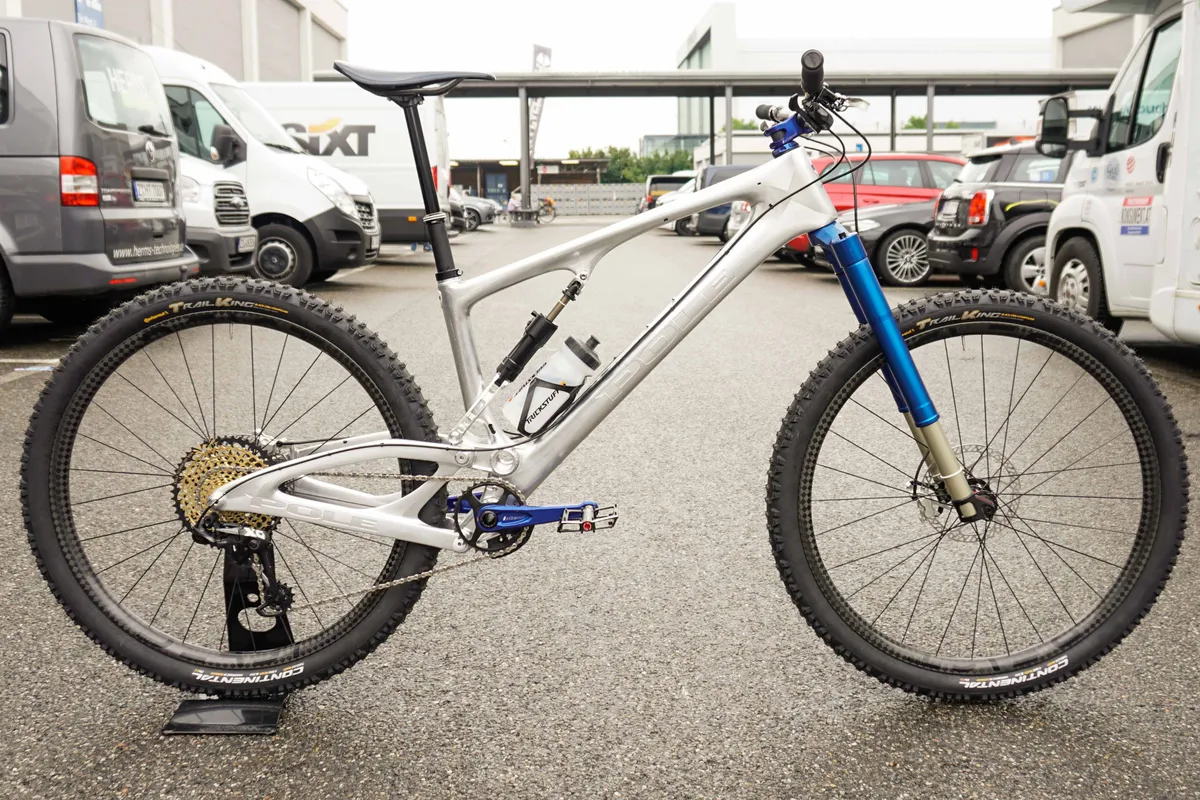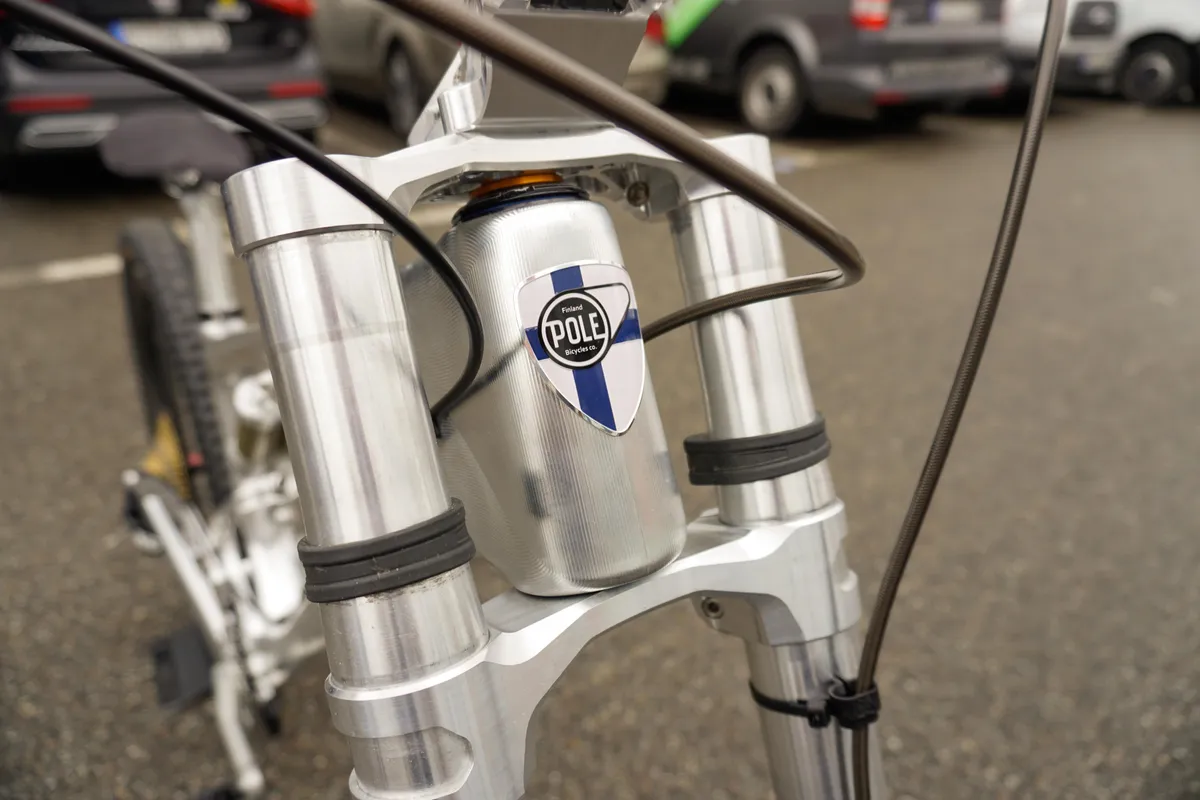As a self-confessed perfectionist, Cornelius Kapfinger (who’s name does sound like an especially ingenious Bond villain) is behind relatively new suspension company Intend, which wants to produce the highest quality products that function better than anything else on the market.
Kapfinger also wants to make sure the people connected with his products are paid a fair wage and to foster close relationships with suppliers and customers.
- Trust launches another bonkers linkage fork with longer travel
- The FSA KFX range could be the lightest production XC components on sale

These are fantastically honest and admirable pillars for running a company, but for the consumer the proof will be in the pudding: do the products work as well as they should and do they offer a combination of better value, performance and aftermarket support than the big players?
Time and tests will be able to answer those questions, but for the moment we're just excited to get a first look and chat with the enthusiastic Kapfinger.
Intend Hero suspension fork

Its most notable feature is its upside-down orientation.
Unlike traditional forks, the fork stanchions are at the bottom, with the crown and steerer mounting directly to the upper body, which also contains the damper and springs.
This helps to reduce un-sprung mass which can improve the suspension’s action.
As the most trail orientated fork in Intend’s range, the Hero has a maximum 150mm of travel, which can be reduced in 10mm increments.

The fork has a 110 x 15mm Boost axle and is capable of taking 29in wheels, and weighs a claimed 1,750g — a 650b fork is in the making.
The fork has got external rebound and compression damping and uses an air spring with a large negative air chamber. This, Kapfinger told us, should help to improve the fork’s small bump sensitivity further compared with traditionally-sized springs, and when combined with the upside-down design should create an incredibly supple fork.

The fork is available with 48mm offset and in black, blue and raw finishes.
Kapfinger tells us that the Hero is roughly equivalent to the RockShox Pike and retails for €1,799 including VAT — taking around three months to get ready after order.
Intend Edge suspension fork

The Edge builds on the Hero’s upside-down chassis, beefing it up for the longer travel.
Intend claims that upside-down forks have very small amount of fore and aft flex. This flexing, it says, is basically undamped and controlled, so the more you can eliminate it the better.
Intend does admit, though, that upside-down forks have small amounts of controlled, and therefore damped, torsional movement. This torsional flex is what people generally refer to when they say their forks are ‘flexy’, especially in turns.

Kapfinger says that this sort of flex, especially when controlled, is advantageous for improving ride-feel and helping you to fatigue less over rough terrain.
Like the Hero, the Edge also has a large negative air spring that's claimed to give it fantastic small bump sensitivity.
It’s available with both 110 x 20mm or 110 x 15mm Boost axles or 20mm and 15mm non-Boost axles. It’s got up to 180mm of front wheel travel that can be reduced in 10mm increments.

There are both 650b and 29er wheel variants available. The 650b bike has a 44mm offset and the 29er gets both 44mm or 51mm depending on your preferences.
The 650b weighs a claimed 1,990g, while the 29er version tips the scales at 2,030g.
The fork retails for €1,949 and is available in blue, black or raw colours.

Intend Infinity suspension fork

Intend claims the Infinity is the ultimate DH fork with supreme fore and aft stiffness, lower un-sprung weight thanks to the upside-down format and better bushing lubrication and higher bushing distances — once again thanks to the upside-down format.

Like the other forks in Intend’s range, it has a large negative air spring with travel topping out at 215mm that can be reduced in 10mm increments.

It has a 51mm offset and can run either a 20mm or 15mm Boost axle but is compatible with non-Boost axles, too. The 650b fork can work with 26in wheels and there is also a 29er version available.
You get adjustable rebound and compression damping with an air spring that features progression control.

The Infinity will set you back €2,049 and like the rest of Kapfinger's products, it’ll take around three months to deliver from the day you order.
Intend Hover rear shock

Touted as an air shock that feels like a coil shock, the Hover uses an in-series spring and damping circuit that works using the same principles as Scott’s and Cannondale’s old pull-style shocks. The Hover is a push shock, however.
Kapfinger claims there are advantages to using this system, which include a long overlap of the piston rod and a large negative air chamber.

There’s an externally accessible cap that lets you install bottom-out tokens without needing to remove the shock from the bike to adjust the shock’s spring ramp and without needing to remove it from the bike.
Like the rest of Intend’s suspension products, the shock has a large negative air chamber, but unlike its range of forks, the Hover rear shock is separately adjustable so that the shock can be tuned to any rider’s preferences.
The negative air chamber is adjusted separately with a fine-tune knob. Twist the adjuster clockwise and you can inflate the negative air chamber and, with the adjuster out, the shock’s positive and negative chambers are inflated at the same time.

Other benefits, Intend claims, are better heat dissipation because the shock has a large outer surface. Repositioning the air can away from the damper in a large separate unit should help it to expel heat more efficiently than a regularly-designed shock.
Heat in suspension normally decreases damping and spring performance, so this move should help to improve on-trail characteristics essentially giving you more control.
Intend also says there’s one less seal on its Hover system compared to a traditionally-designed shock. It also says that the shock’s main seals are always covered in damping oil so can’t dry out, which should be good for longevity and plush performance.
Traditionally-built shocks can suffer from air cavitation in their oil which happens over time and causes it to become noisy or make sucking or whooshing noises as it compresses. Intend’s Hover is no different, however Kapfinger has devised a way to bleed the shock’s oil externally using a small valve located on the inside of one of the eyelets.

In a bold move, Kapfinger is offering the Hover in a large range of metric, metric trunnion sizes and imperial shock sizes with the only major exceptions being 190 x 50mm and 222 x 70mm.
Externally the shock has both low-speed rebound and compression damping adjustments with high-speed adjustments taken care of by internal shim stack alterations.
The shock is going to cost around €989 which includes a re-tune, if you require. The shock should be available to buy soon.
Intend Grace DH stem
As another addition to its rather funky-looking range of components is the direct-mount Grace DH stem, which is offered in 35mm bar clamp diameter with a maximum 25mm rise.
It is possible to use it with 31.8mm handlebars but you’ll need a special adaptor for your bars.

The stem’s unqiue looks are the solution to the problems posed by riser stems or stem stackers and spacers reducing the bike’s reach — the further up the stem rises, the closer to your body the bars become as they travel upwards on the same axis as your head angle.
The Grace stem’s forward angle should, Kapfinger says, help to counter this effective reduction in reach.
The stem’s not cheap, though, coming in at €169.

